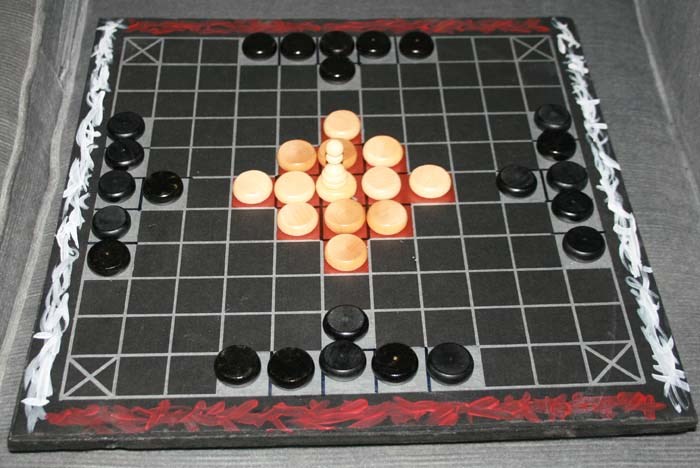As has been the case in recent weeks I have been going back and looking at some well-loved games which have somehow been overlooked as I have written this review weekly in past years.
This week I am correcting the oversight of Hnefatafl.
There are reports of Hnefatafl-like games dating back to as early as the year 400, which tells you the game has something going for it to still be played today.
As one of the oldest games in the world with versions credited to the Vikings, Welsh, Saxons, and Irish, Hnefatafl has origins which can be traced through the game Petteia, played by the Romans, and likely earlier to similar style games played by the Ancient Greeks and Egyptians.
Even today the game has a number of versions.
“This game is hnefatafl, also known in its various forms as tafl, brandubh, tawlbwrdd, alea evangelii and tablut, and less certainly by some as gwyddbwyll and ficheall,” details www.tafl.cyningstan.com
“It is a game of skill in which a king tries to escape, with the help of his men, from a numerous besieging army.”
The same website provides a more in-depth look at the game’s intriguing history, only a taste provided here. I highly recommend the site for further exploration of the game.
“Hnefatafl began its life in Scandinavia. It probably developed from a Roman war game called ludus latrunculorum, which in turn developed from petteia, a game of the Greeks. In its Scandinavian form, hnefatafl was taken through trade and invasion to the British Isles, to Iceland, France, Germany, the Ukraine and to Greenland. In addition to many finds in its ancestral home, boards, pieces and literature for many variants have been found in diverse parts of northern Europe. The game flourished until the arrival of chess.
“Just as hnefatafl had replaced the earlier Roman game, so chess replaced hnefatafl as the fashionable game for all classes. Also joining this onslaught was the relatively new game of draughts: against this two-pronged invasion, hnefatafl stood little chance. Hnefatafl continued to linger in remote districts after its fall from grace, and it is from this late period that our best information comes. Detailed information comes down to us about a game in Wales in the sixteenth century, and in Lapland in the eighteenth century
“After this, however, the light went out for a hundred years, until in the nineteenth century the game was revived with a Crimean War theme. Throughout the twentieth century, more and more has been rediscovered about the game. Archaeologists have uncovered many boards and fragments, historians have thrown light upon old passages once thought to refer to chess, and reconstructionists have used all this information to construct rules for the variants played on many different sizes of board. Factories and modern cottage industries have manufactured sets for the game, and some game designers have even created new games with hnefatafl as an obvious inspiration.”
What has probably been the reason for the games long-time survival is that Hnefatafl is one of the rare breed of games with two unequal sides.
Most abstract strategy games hnefatafl would be compared to, chess leading that comparison, have equal forces facing off across the board. Both players start with the same array of pieces.
But if a game is to in some abstract way mimic a battle, forces are rarely exactly matched.
In hnefatafl players get to experience what it is like when forces are not nicely matched.
The defending side comprises twelve soldiers and a king, who start the game in a cross formation in the center of the board. Their objective is for the king to escape by reaching any of the four corner squares.
The attackers comprise 24 soldiers positioned in four groups of 6 around the perimeter of the board, and their mission is to kill the king.
All pieces move like the Rook in chess.
In hnefatafl pieces are taken by custodial capture, which means an opposing piece must be flanked on two horizontal or vertical sides by two pieces of the other army in order to be captured. There are some added rules regarding using two safe corners and middle square on the board to capture, but the exceptions are easily understood by reading any of the rulesets out there.
As noted in the above history, sets are available through an easy Internet search.
The game is also easy enough to fashion at home (see photo). While not fancy, it is core board, using paint and felt markers, the board is function, and checkers are usually part of any serious board gamer’s closet.
Overall hnefatafl has held its age well. There is a lot of strategy here, not quite chess, more than checkers, but with the added intrigue of the unbalanced forces.
If you love chess and checkers, then hnefatafl is a game you really need to explore.



